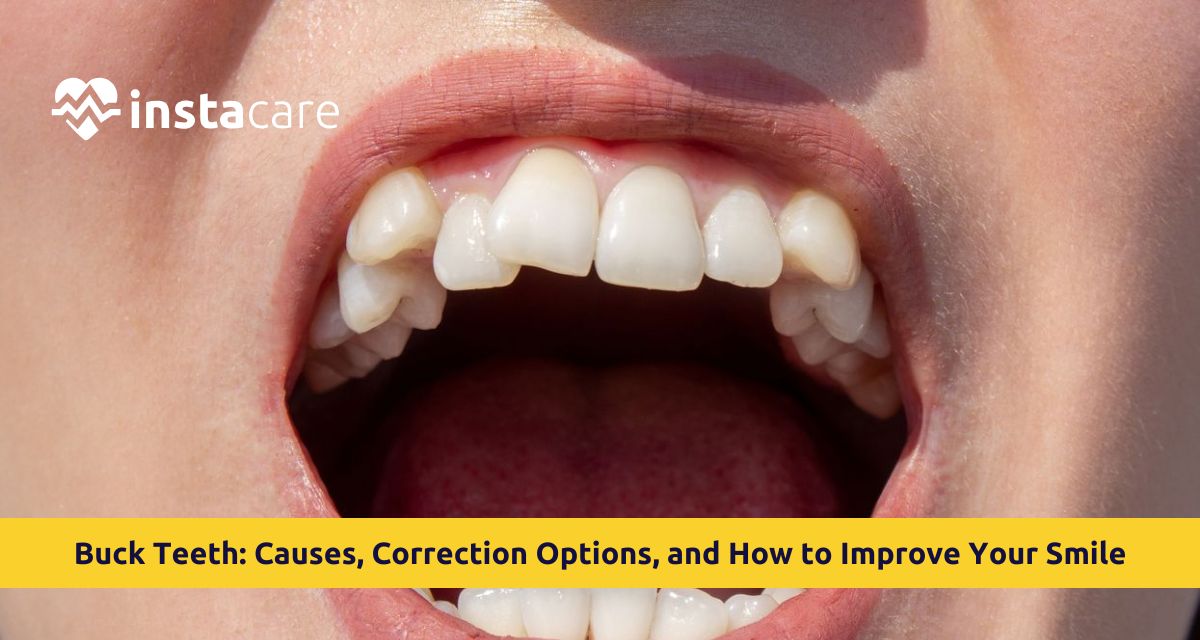What Are Buck Teeth?
Buck teeth are when front upper teeth stick out further forward over lower teeth. That's not the same as a normal overbite, when teeth cover the lower teeth vertically. Buck teeth vs overbite is an applicable distinction—overjet is to measure horizontal protrusion, and overbite is to measure vertical overlap.
A buck teeth smile is generally characterized by forward incisors of the upper teeth that protrude. The conditions are cosmetic in minor cases, while extensive protrusion results in impairment of speech, feeding problems, and increased susceptibility to trauma. The condition ranges from minor protrusion to severe forward displacement and requires professional care.
Common Causes of Buck Teeth
Genetic Origins
Heredity has the largest impact on denture shape. If your parents possessed protruding teeth or jaw abnormality, you are most likely to develop their characteristics. Inherited variations in jaw sizes—a larger upper jaw than the lower jaw most commonly lead to buck teeth.
Childhood Habits
Continuing thumb sucking beyond age four forces upper teeth forward and influences jaw growth. Pacifier use for a long time brings on the same types of pressures. Tongue thrusting, where tongue thrusts forward into front teeth when swallowing, slowly forces teeth out over time.
Jaw Development Issues
Buck teeth and jaw alignment issues often happen together. Underdevelopment of the lower jaw, also known as retrognathia, results in the upper teeth protruding more. Overdevelopment of the upper jaw yields forward actual protrusion. These types of discrepancies in the bone require treatment processes other than straightforward anomalies of tooth position.
Missing or Overcrowding Spaces of Teeth
Missing teeth push adjacent teeth forward. Crowding from too much space, meanwhile, pushes front teeth outward in search of space.
Tumors or Cysts
Sometimes, jaw or mouth tumors push teeth out of alignment and suddenly push them forward rather than gradually.
Potential Problems Caused by Buck Teeth
Physical Effects
Pointing teeth are more likely to get injured by falls or sports. They hinder the proper closure of lips, resulting in mouth breathing and drying out of the mouth, exposing the person to having
cavities. Serious conditions render biting, chewing, or speaking normally highly difficult.
Oral Issues
Poor biting leads to abnormal wear of enamel between teeth. Malocclusion may result in temporomandibular joint (TMJ) syndromes, which create pain, clicking, or difficulty in opening the mouth. Protruding teeth are difficult to clean between, and this results in increased plaque and gum disease.
Self-Esteem Issues
Most individuals with buck teeth have some form of social discomfort or self-esteem issue about their appearance. Buck teeth self-confidence issues can damage relationships, career opportunities, and overall health, so correction is well worth it for reasons beyond cosmetics.
Treatment Options for Buck Teeth
Orthodontic Braces
Braces for buck teeth remain the gold standard for full correction. Metal or ceramic braces gradually move teeth in 18-36 months. Braces straighten the jaw and teeth malalignment. Braces can be fitted on anyone, though treatment is quicker when carried out in children and young adults. Buck teeth before and after braces show stunning contrasts, with well-aligned teeth and improved facial contours. Orthodontists make use of rubber bands or headgear in addition to braces when there is significant repositioning of the jaw.
Clear Aligners
Can Invisalign fix buck teeth? Yes, for mild to moderate buck teeth. They're removable plastic trays that push teeth forward a little at a time with carefully crafted pressure zones. It's the same therapy as using regular braces but with aesthetic advantages and improved oral hygiene. There are limits, though, in serious protrusion or serious misalignment of the jaw.
Tooth Extraction
Extraction of teeth creates room for the other teeth to shift naturally into their proper positions. Premolars are usually removed by orthodontists for maximum success to be achieved. This is usually followed with braces or aligners for final alignment.
Palate Expanders
In a person with a narrow upper jaw, palate expanders widen the jaw before the permanent teeth come in. This provides enough space and prevents future protrusion, correcting issues ahead of time.
Surgery
Buck teeth surgery will be needed if bone issues result in severe protrusion. Orthognathic surgery relocates the jaw itself, and not teeth. Surgeons can move the lower jaw forward or retract the upper jaw. It heals within several weeks but the result greatly improves function and appearance. Surgery usually is followed by braces for optimal alignment.
Veneers or Bonding
Small buck teeth that stick out in buck teeth in adults needing urgent cosmetic correction, veneers or bonding correct tooth appearance without their movement. They do not correct issues of underlying function and alignment, however.
Correction Without Braces
Buck teeth correction without braces has a couple of alternatives. Invisible treatment for suitable candidates can be done using clear aligners. Mild cases are sometimes an option in some cases with removable retainers along with tooth recontouring. Veneers are used by some adults as a cosmetic modification without orthodontic modification. Although non-braces approaches do have their own limitations. They tend not to correct jaw misalignment or poor protrusion as well as full orthodontic treatment does. Your visit with an orthodontist will clarify which is best for your individual case.
At-Home and Preventive Measures
For Children
Avoid sucking the thumb beyond the fourth year of age by suggesting favorable habits. Restrict the use of pacifiers beyond two years of age. Stop tongue thrust by therapy through myofunctional exercises. Early evaluation by an orthodontist at around the age of seven identifies problems in development.
General Prevention
Routine visits to catch issues early. Give children plenty of calcium and vitamin D to support jaw formation. Guard teeth in sports with the right fitting mouth protectors.
What Doesn't Work
Avoid home fixes like rubber bands or web "solutions." They do extensive harm like tooth loss, root fracture, and unwanted movement that need to be fixed by high-level specialists.
When to See an Orthodontist
See a dentist if buck teeth are interfering with eating, speaking, or breathing through the nose. Kids need to be checked at age seven, even if everything seems fine—treat before things become complicated. Adults with jaw pain,
grinding of teeth, or low self-esteem can probably be treated. Emergency check-up is necessary if there is sudden protrusion of teeth, indicating underlying jaw cysts or tumors. Excessive protrusion with danger of damage requires immediate professional check-up.
Conclusion
Knowledge of the causes of buck teeth and buck teeth treatment makes you a knowledgeable decision-maker of your treatment. How to fix buck teeth through braces, clear aligners, or surgery are your choice regardless of your age. Efficient treatments are offered by modern orthodontics to all. Treatment of buck teeth not just makes them attractive but also restores oral well-being, function, and health.
Please book an appointment with the
best Dentist in Lahore, Karachi, Islamabad, and all major cities of Pakistan through
InstaCare, or call our helpline at 03171777509 to find a verified doctor for your disease.

